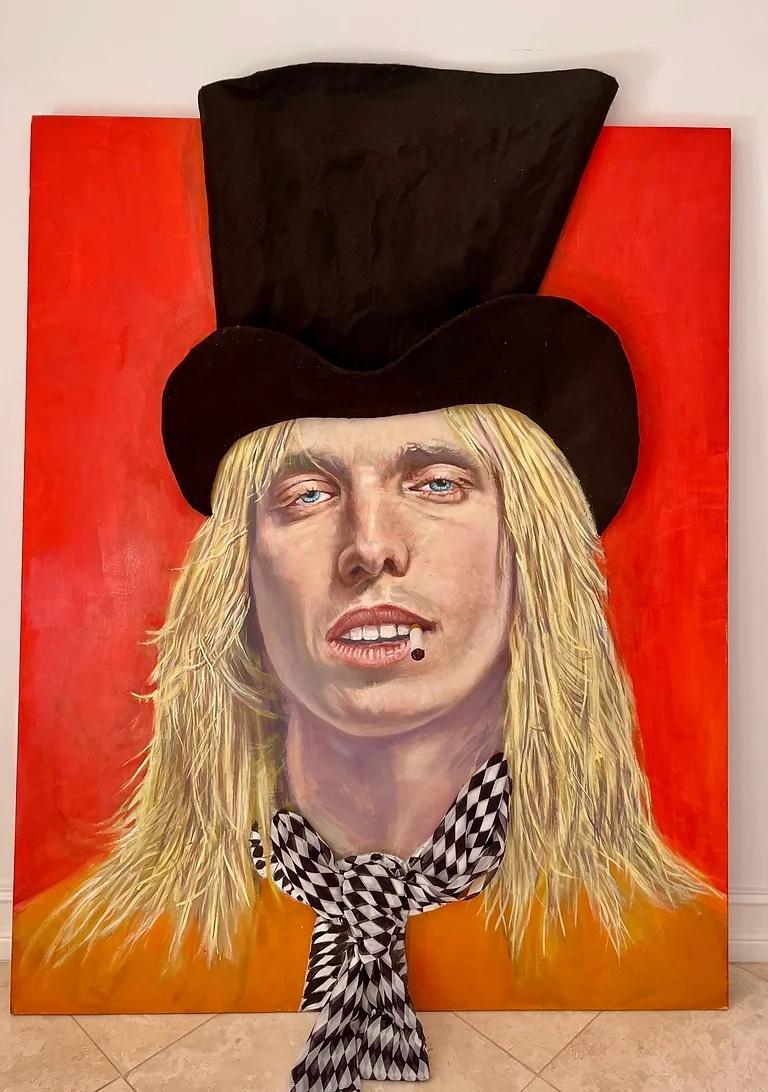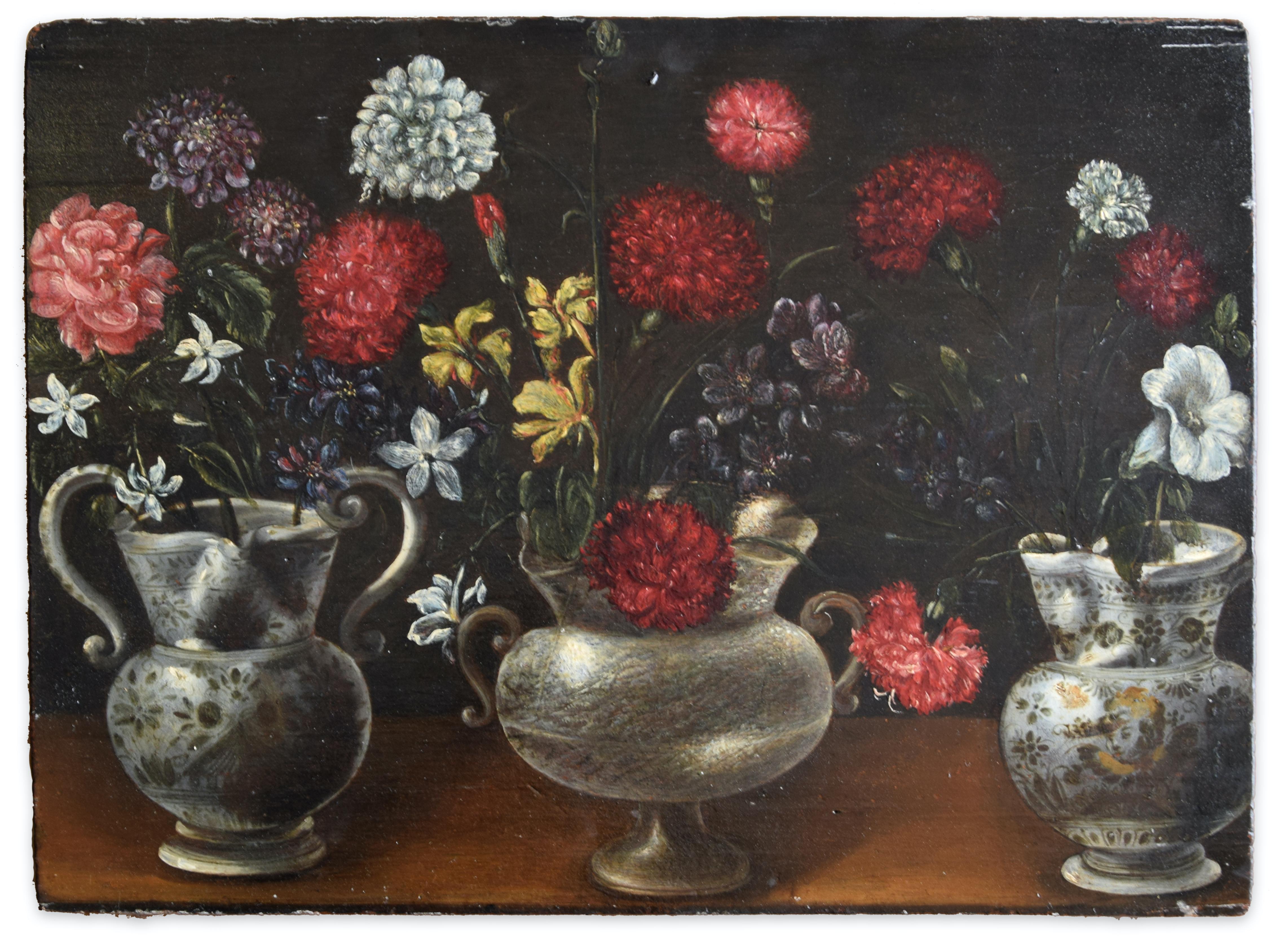Items Similar to The Crucifixion
Want more images or videos?
Request additional images or videos from the seller
1 of 4
Flemish School, 17th CenturyThe Crucifixion
About the Item
The Flemish School, also known as the Northern Renaissance, the Primitive Flemish School and the Early Dutch School, refers to artists active in Flanders during the 15th and 16th centuries, particularly in the the cities of Bruges and Ghent. The three most prominent painters of the period – Jan van Eyck, Robert Campin and Rogier van der Weyden – are known to have made significant strides in illusionism, or the realistic and accurate depiction of people, spaces and objects. The Flemish School’s favorite subjects were often religious in nature, but small portraits were also popular. The majority of these works are in the form of plates, simple altars or more complex altars, often in diploid or polyploid form.
During the 15th and 16th centuries, the Netherlands became a political and artistic center centered around the cities of Bruges and Ghent. The Flemish school arose almost at the same time as the Italian Renaissance. However, while the Italian Renaissance was based on a rediscovery of classical Greek and Roman culture, the Vlaanderen school drew influence from the region’s Gothic past. These artists also experimented with oil painting earlier than their Italian Renaissance counterparts.
Provenance:
Private collection, Zürich, Switzerland
- Creator:Flemish School, 17th Century (1600 - 1699)
- Dimensions:Height: 46.8 in (118.88 cm)Width: 33.3 in (84.59 cm)
- Medium:
- Period:
- Framing:Framing Options Available
- Condition:
- Gallery Location:Zürich, CH
- Reference Number:1stDibs: LU2570213268322
About the Seller
No Reviews Yet
Vetted Seller
These experienced sellers undergo a comprehensive evaluation by our team of in-house experts.
Established in 2007
1stDibs seller since 2023
Typical response time: 8 hours
- ShippingRetrieving quote...Ships From: Zürich, Switzerland
- Return PolicyThis item cannot be returned.
More From This SellerView All
- Stopover for Riders in a VillageLocated in Zürich, CHJoost Cornelisz Droochsloot or Droogsloot was a Dutch Golden age painter of village scenes, landscapes, genere pictures, moral allegories and biblical stories. He was born in Haarlem, and he was a pupil of Esaias van de Velde...Category
17th Century Dutch School Figurative Paintings
MaterialsOil
- DaydreamsBy Grigory GluckmannLocated in Zürich, CHGrigory Gluckmann Vitebsk 1898 – 1973 Los Angeles "Daydreams" Oil on panel 71 by 89 cm Signed (lower right) “Gluckmann”; variously labelled (on the frame) Born in Russia in 1898, G...Category
20th Century Impressionist Figurative Paintings
MaterialsOil
- CompositionBy Grigory GluckmannLocated in Zürich, CHGrigory Gluckmann Vitebsk 1898 – 1973 Los Angeles "Composition" Signed in Latin (lower right) “Gluckmann” Born in Russia in 1898, Grigory Gluckmann studied in Moscow and eventually ...Category
20th Century Impressionist Figurative Paintings
MaterialsOil
- Boar HuntBy Abraham HondiusLocated in Zürich, CHAbraham Hondius, a Dutch painter of the Baroque period, was born into the family of a stonemason. He studied painting under Cornelis Saftleven (1607/08 – 1681) and possibly under Pie...Category
17th Century Paintings
MaterialsOil
- A Guardroom Interior with a Seated Woman Amongst PlunderLocated in Zürich, CHJacob Duck (1600–1667) was a Dutch Golden Age painter who specialized in guardroom interiors, or “cortegaerdje.” He was born in Utrecht, the Netherlands, an...Category
17th Century Paintings
MaterialsOil
- Boy and a Girl with a CatBy Jan Miense MolenaerLocated in Zürich, CHJan Miense Molenaer was a Dutch Golden Age genre painter whose style was a precursor to Jan Steen’s work during Dutch Golden Age painting. He shared a studio with his wife, Judith Leyster, also a genre painter, as well as a portraitist and painter of still-life. Both Molenaer and Leyster may have been pupils of the successful Dutch painter, Frans Hals. Molenaer was born and died in Haarlem. He achieved a style close to Hals’ early on in his career, but later developed a style like that of Dutch genre painter, Adriaen van Ostade. His genre works often depicted players of music, such as his The Music Makers (Museum of Fine Arts, Budapest), The Duet(Seattle Art Museum), or Family Making Music (Frans Hals Museum). He also depicted Taverns and the activities of card games or games of the times such as La main chaude, or in Dutch, Handjeklap, which literally means clapping hands. Molenaer also cleverly depicted biblical stories in his own time and surroundings, such as representing a scene from Peter’s Gospel set in a Dutch Tavern...Category
17th Century Paintings
MaterialsOil
You May Also Like
- "Obliteration" Oil and Alkyd Painting on Wood Panels, Yellow, Red, OrangeBy Grace Graupe-PillardLocated in New York, NYGrace Graupe-Pillard has concentrated on portraiture since her early charcoal drawings which she exhibited at The Drawing Center, NYC in 1981. Her work, which has been exhibited at notable institutions such as MOMA PS1 and galleries including Cheim & Read Gallery (NY) and Carl Hammer Gallery (Chicago), has evolved from over the years from pastels to large-scale oil paintings and installations of people who she describes as “having not been integrated into mainstream society.” Her more recent paintings, inspired by selfies and iPhone photographs, attempt to convey the vitality and diversity of 21st century contemporary culture while capturing the ineffable moments in our lives. “The sensuality and radiant beauty of youth and ethnic diversity are depicted in my choice of subjects, as well as the ravages of time which are imprinted on our being. All stages of life are filled with humanity that both elevates and dissipates the spirit.” Her work has been written about in The NY Times, Art News, The Village Voice, The Star-Ledger, Newsday, Flash Art...Category
2010s Contemporary Paintings
MaterialsOil, Alkyd, Paint, Wood Panel
- The IntruderBy Arthur Fitzwilliam TaitLocated in New York, NYArthur Fitzwilliam Tait was born at Livesey Hall, near Liverpool, England, and began his career as a clerk at the gallery of Agnew & Zanetti’s Repository of Arts in Manchester. While...Category
19th Century American Realist Animal Paintings
MaterialsOil, Wood Panel
- Smoking Tom PettyBy Serge StrosbergLocated in West Palm Beach, FLTom Petty Fans! Welcome to Tom Petty Nation! This Original Oil, egg tempura, Enamel paint, glass, custom made felt hat, textile, metal mesh, on wood panel is a beautiful tribute to ...Category
21st Century and Contemporary Modern Portrait Paintings
MaterialsMetal, Enamel
- Portrait of Gentleman, Thomas Bruce, Earl of Elgin c.1638 Manor House ProvenanceLocated in London, GBTitan Fine Art present this picture which formed part of a historic collection of an English aristocratic family, Lord and Lady Sandys at their magnificent baroque and Regency Grade-...Category
17th Century Old Masters Portrait Paintings
MaterialsOil, Wood Panel
- Portrait of a Lady Diana Cecil, Countess of Elgin c.1638, Manor House ProvenanceLocated in London, GBTitan Fine Art present this picture which formed part of a historic collection of an English aristocratic family, Lord and Lady Sandys at their magnificent baroque and Regency Grade-...Category
17th Century Old Masters Portrait Paintings
MaterialsOil, Wood Panel
- Still Life of Bouquet in two-handled vases - Oil on Panel by Vincenzo dé FioriLocated in Roma, ITStill Life is a superb original oil painting on panel, realized by the Italian artist Vincenzino Volò, best-known as Vincenzino dei Fiori (Rémondans, 1620-Milan, 1671) around 1640-1660. Original Title: Natura morta di fiori entro vasi biansati (Still life of Bouquet in two-handled vases). On the back of the panel, two labels are glued "da Milano", "A Piacenza", ("from Milan" "to Piacenza"). The labels indicate a transfer of the artwork, perhaps in the first half of the twentieth century, from Piacenza to Milan. While instead the style and technique make us understand the artwork was commissioned or created in the Milan of Federico Borromeo, archbishop of Milan from1595 to 1630. The author of the painting can be identified in the person of Vincenzo Volò, a talented artist who fell into oblivion, recently rediscovered and appreciated. Founder of the Vincenzini family, he was born in Franche-Comté in 1620 (in the past its birth was erroneously fixed to 1606). In the mid-forties of the seventeenth century he arrived to Milan, and held a leading artistic role: he was the founder of a family workshop that imposed his style and strongly influenced Milanese collecting with his still lifes and influenced generations and generations of painters. Vincenzino also was the first painter of still life to work on the Bella Island for Vitaliano VI Borromeo and collaborated with well-known figure painters such as Francesco Cairo, Scaramuccia, Nuvolone and Fumagalli. As regards the style, the archaic tendency of Lombard painting of still life from the early decades of the seventeenth century is clearly evident, looking at primitivism and the happy schematization of the composition of the artwork. The dating of this artwork could be fixed around the first half of the seventeenth century because it is confirmed by the type of support, a wooden panel, always used by Vincenzino. As for the subject, Volò generally painted bouquets of flowers in two-handled vases placed on transversal planes seen from the front. It is possible to compare this work with other Dei Fiori's artworks: the pair of Flower Vases...Category
Mid-17th Century Still-life Paintings
MaterialsWood Panel, Oil
Recently Viewed
View AllMore Ways To Browse
Artist Of The 17th Century
Swiss School
Art Flemish
Religious Greece
17th Century Oil Paintings
17th Century Plate
Flemish Paintings Century
Northern School
Flemish Paintings
17th Century Panel
17th Century Netherlands
17th Century Italian Painting
16th Century Dutch
Dutch Painting 17th
Dutch Painting 17th Century
Painted 17th Century Italian
15th Century Italian
15th Century Italy





